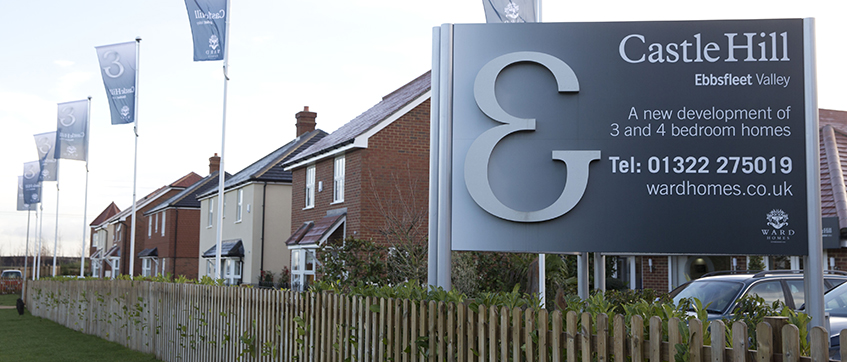Ebbsfleet Garden City: From industry joke to national leader
Ebbsfleet Garden City. Three words that have been an industry joke in recent years, and a project that has typified the failure of the housebuilding industry.
Originally granted consent back in 2002, until last year the scheme had delivered just 65 of the planned 15,000 homes.
Fast-forward to today and 640 homes were started in the last financial year. Seven developers are currently on site in Kent, with another three set to join before the year ends. A joke no more.
Ebbsfleet Garden City. Three words that have been an industry joke in recent years, and a project that has typified the failure of the housebuilding industry.
Originally granted consent back in 2002, until last year the scheme had delivered just 65 of the planned 15,000 homes.
Fast-forward to today and 640 homes were started in the last financial year. Seven developers are currently on site in Kent, with another three set to join before the year ends. A joke no more.
Another three words: Ebbsfleet Development Corporation. Set up in 2015, it seems to be the difference.
It and a £275m cash injection from the treasury via George Osborne’s November 2015 budget to be spent on infrastructure. And it seems to be working.
Last month, the corporation secured a groundbreaking £30m deal with UK Power Networks to invest in electricity.
It’s the first time a public body has invested in this way to unlock development. The money will be claimed back when developers pay for the proportion of electricity they need.
It is innovation like this that typifies similar forward-funding deals that the development corporation is spearheading, which will ultimately reduce developers’ costs and hopefully continue the momentum gained over the past couple of years.
Having finally got Ebbsfleet moving after all this time, the corporation is a template for both the private and public sectors to work from for other stalled projects.
So why did it take so long to get going?
Landsec, which controls around two-thirds of the site, says it took a while to create a market.
It acquired Whitecliff Properties in February 2001 for £60m. As part of the deal, it inherited around 1,000 acres of land around Ebbsfleet, with the promise of a new high-speed railway line, linked to both London and Europe, which opened in 2007.
Targets
2021 – 5,000 homes
2026 – 10,000 homes
2031 – 15,000 homes
Jon Levy, development director at Landsec, says: “The original scheme was going to be much more commercial than the current one.
“Pre-Lehmans it was going to be almost another Canary Wharf. The world then held its breath in 2008, the market changed and Ebbsfleet had to evolve.
“Even with the benefit of great transport links, we had to start from scratch again, from absolute nothing remember, a disused quarry.
“It’s taken time to get to where we are today, but around a quarter of our 10,000-home pipeline is now in the hands of housebuilders.”
The development corporation was inaugurated at the end of 2015 and chief executive Paul Spooner says it took a while for the trust to form between the new organisation and Landsec.
“There was no joined-up approach and large upfront infrastructure costs went unmet,” he says.
The development corporation has tried to plug that gap, co-ordinating a total of 37 – and growing – public and private sector agencies.
Its job is to essentially incentivise the housebuilding industry, putting in the basic infrastructure so developers can get on with building homes.
Spooner takes great pleasure in saying the planning team has a 100% record of turning around applications in the statutory time limit.
“We pride ourselves on being a very positive planning authority, moving through streamlined processes to get applications to committee as quickly as possible without any disregard for quality. People can then bring forward plans, knowing they can get on site quickly.”
Actual forecast
Current prices being achieved at Ebbsfleet are around 350-£400 per sq ft. That is around half of what is currently being achieved in Stratford, just one stop and 10 minutes away on the high-speed line.
Stratford was achieving the same prices of Ebbsfleet only five years ago, which illustrates the rate of growth in London, but also the potential for uplift in Ebbsfleet.
Spooner says: “Those stuck on the wrong side of the bubble are now looking further afield, and Ebbsfleet presents a great opportunity for Londoners escaping in order to get a foot on the ladder.”
Many large sites up and down the country are held by a single developer. Due to absorption rates, delivery of homes tends to be slow. Not at Ebbsfleet though.
“It hasn’t really been much of an issue, the developers are all competing against each other, with slightly different products and offers” says Spooner.
Land Registry data reveals a vast premium to the nearest established town at Swanscombe, with new-build prices in Ebbsfleet’s new town around 60% higher than those second-hand sales nearby.
Developers currently on site
Redrow
Barratt
Taylor Wimpey
Countryside
Clarion
Persimmon
Newcrest
The housebuilders currently on site say their primary market is those within 10 miles of Ebbsfleet, around 85% of all buyers.
However, Spooner believes as more apartments and smaller units come on to the market, more interest has come from people in London coming to get better value for money, as well as those who can’t afford to be in London, but have the benefits of a short commute.
Around 2,500 plots are now in the hands of builders, with many soon to complete. For the time being, Landsec is really just a land trader, gaining consent and offloading to developers.
Its big prize is what is known as the central area, situated around the international station. This will include 4.8m sq ft of commercial development, but still with residential integrated, albeit with much higher density than elsewhere at Ebbsfleet.
A large chunk will also be given over to educational uses, with Landsec currently in talks with both King’s College London and Guys and St Thomas’ about a university-led biomedical cluster for teaching and research.
The REIT is aiming to start this element of the project in about two years.
All the developers, along with other stakeholders, get together once a month for an open-book dialogue. Nothing is off the table, according to Spooner.
Pre-Lehmans it was going to be almost another Canary Wharf. The world then held its breath in 2008, the market changed and Ebbsfleet had to evolve. Even with the benefit of great transport links, we had to start from scratch again
The development corporation needs to know what is going on across the site in order to co-ordinate infrastructure and everything else in between.
It is this approach that Spooner also informally shares with both the London Legacy and Old Oak and Park Royal development corporations, which work under the mayor of London.
“The LLDC is a few years ahead of us and we are a couple of years ahead of Victoria Hills and her team at Old Oak Common. We are constantly sharing our knowledge. It works well.”
Some 75% of the £275m cash injection via the development corporation has to be paid back, whereas a recent £2.3bn Housing Infrastructure Fund announced by secretary of state for communities and local government Sajid Javid to unlock 100,000 new homes is grant funding.
Spooner and his team therefore need to produce a business case for each spend, and invest knowing they will need to make a return.
Could more development corporations work well for big residential schemes and urban edge-of-town extensions?
Levy believes so. “Just knowing that money is available gives confidence to the market,” he says.
“We have now created a market where we have got momentum and confidence going forward, both from homeowners looking to buy and developers looking to build.”
From an industry joke to being on target to build 5,000 homes by 2021, it seems the turnaround is well on its way. As long as a macroeconomic shock isn’t just around the corner.
This article was originally published on 18th August 2017
To send feedback e-mail paul.wellman@egi.co.uk or tweet @paulwellman eg or @estatesgazette











